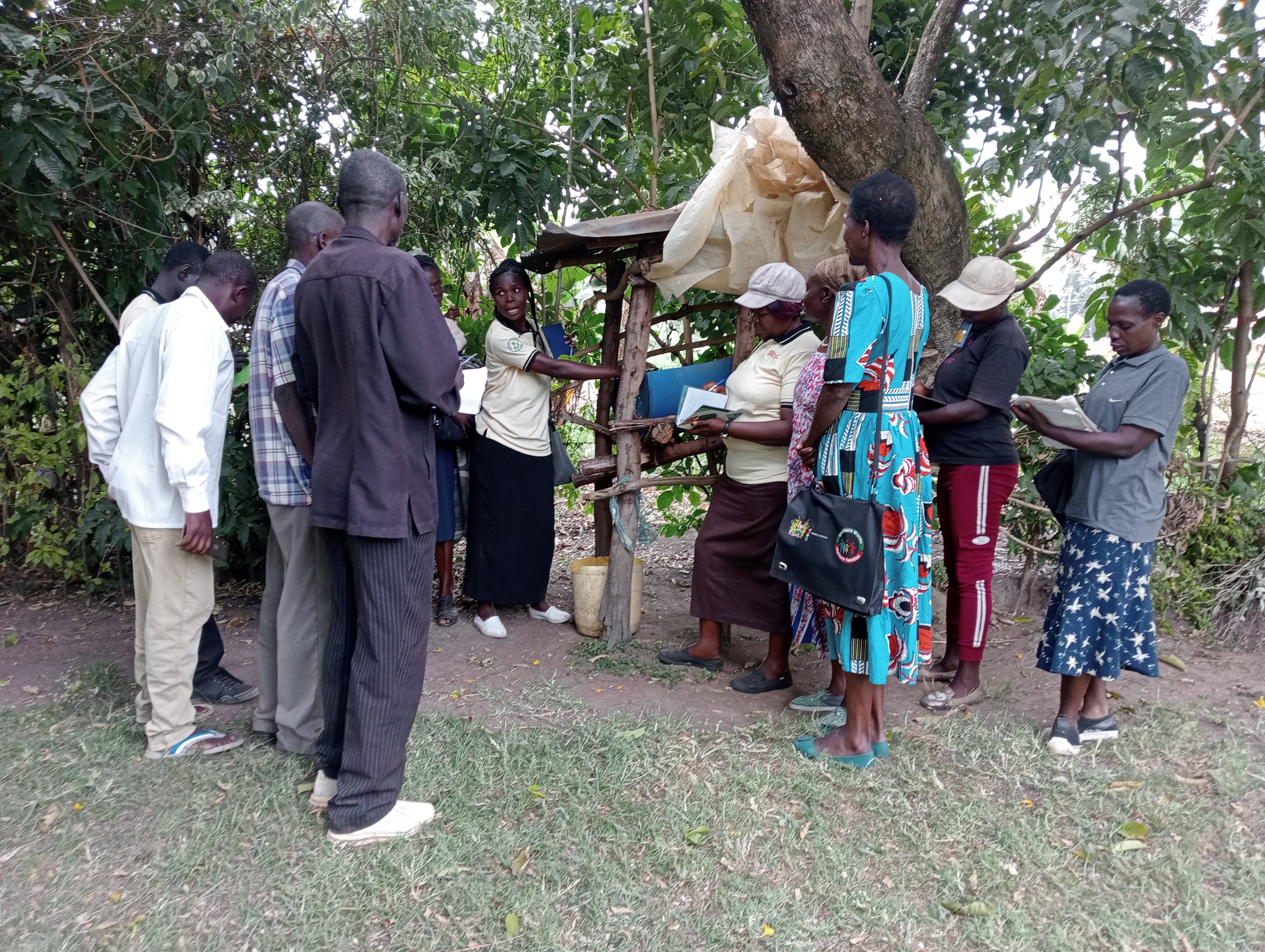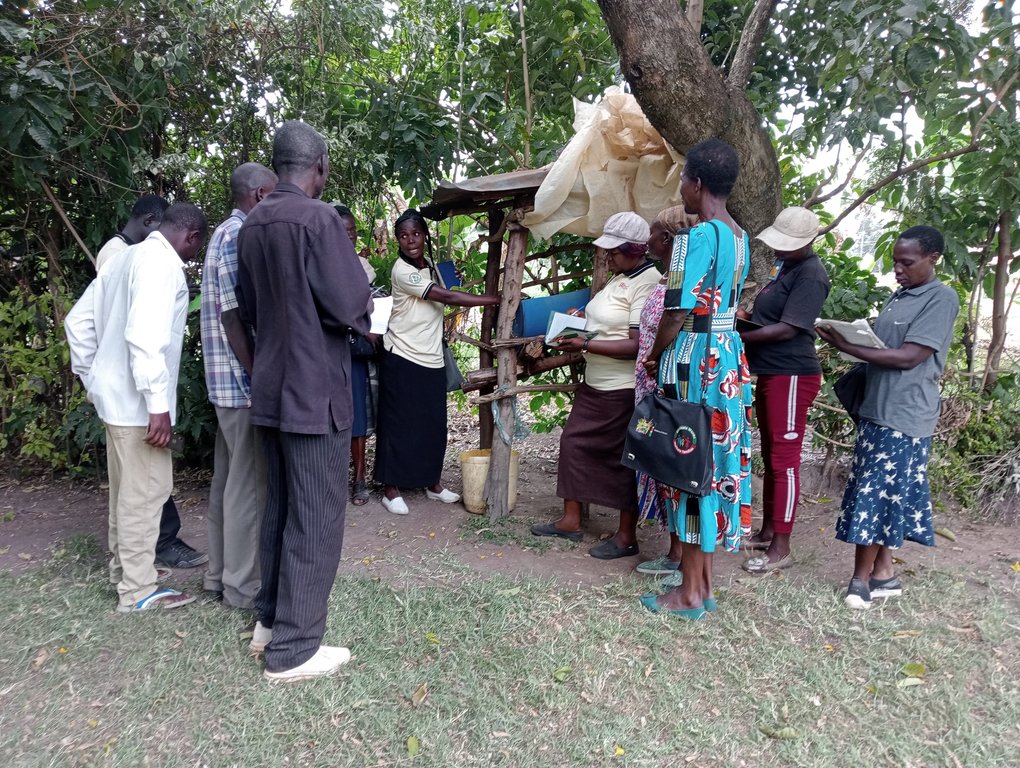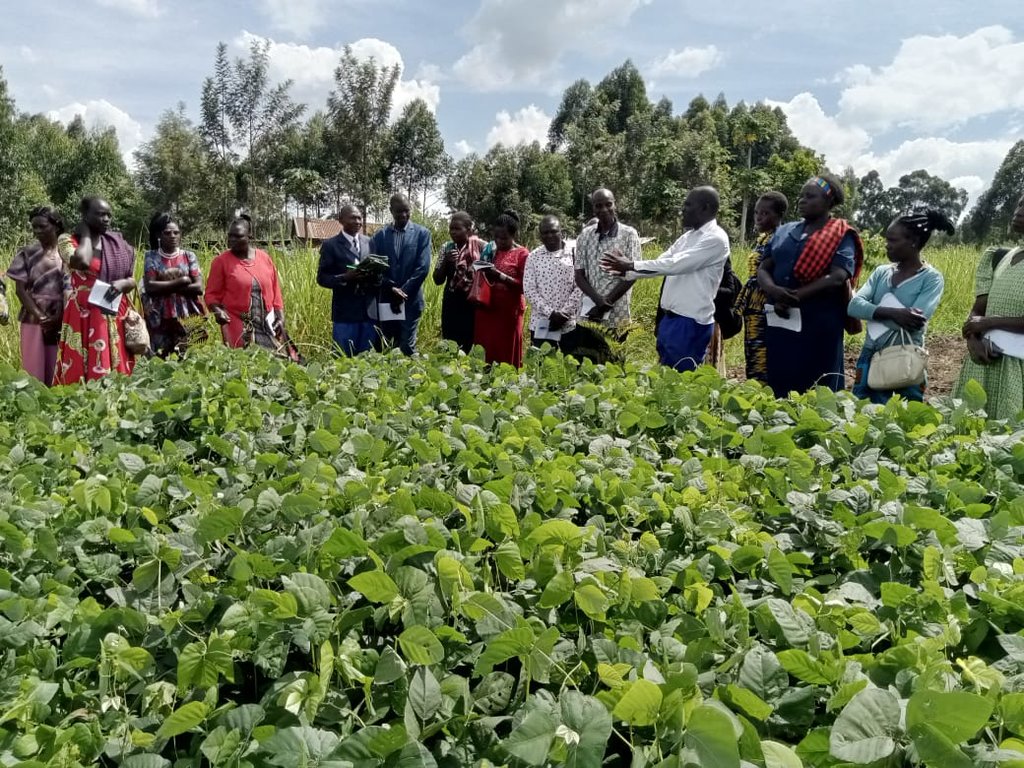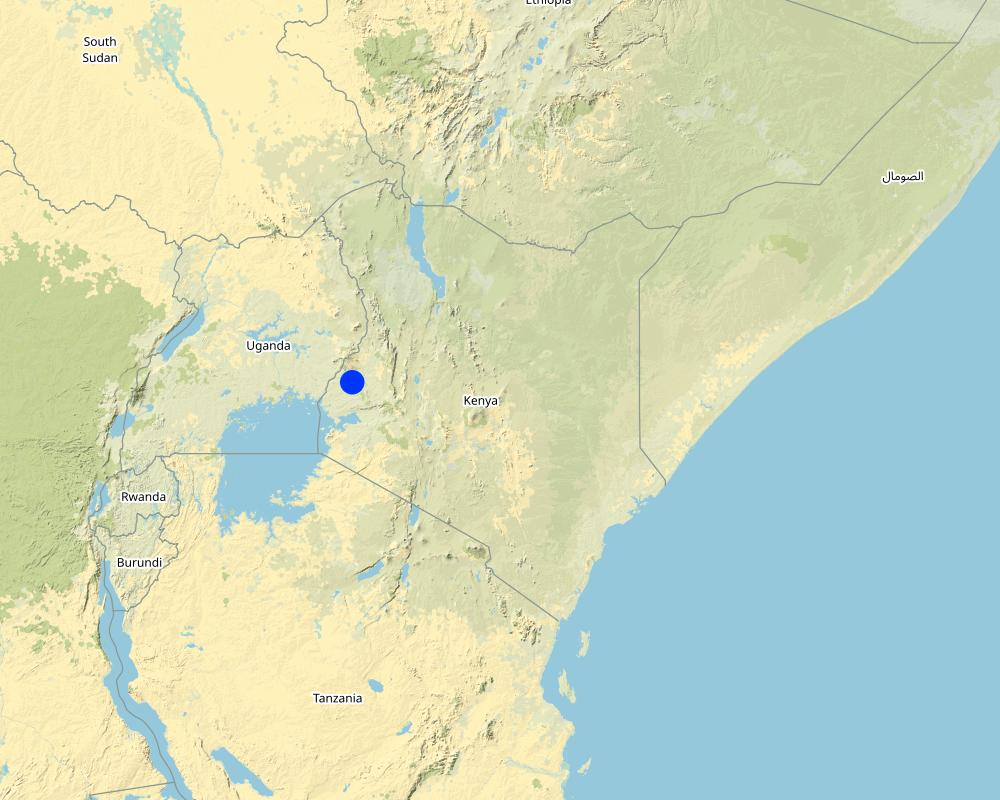Community Resource Persons (CRP) in agricultural extension [Kenya]
- Création :
- Mise à jour :
- Compilateur : William Akwanyi
- Rédacteurs : Maureen Elegwa, Innocent Faith, Noel Templer
- Examinateurs : William Critchley, Rima Mekdaschi Studer
Mtu wa rasilimali za jamii/ Mkufunzi wa wakufunzi
approaches_6688 - Kenya
Voir les sections
Développer tout Réduire tout1. Informations générales
1.2 Coordonnées des personnes-ressources et des institutions impliquées dans l'évaluation et la documentation de l'Approche
Personne(s) ressource(s) clé(s)
Spécialiste GDT:
Nyanja Churchill
+254 710 849370
churchillwn2@gmail.com
Kimaeti Farmers Community-Based Organization (CBO)
Bukembe East Ward, Kanduyi Sub-county, Bungoma County
Kenya
Spécialiste GDT:
Spécialiste GDT:
Nom du projet qui a facilité la documentation/ l'évaluation de l'Approche (si pertinent)
Soil protection and rehabilitation for food security (ProSo(i)l)Nom du ou des institutions qui ont facilité la documentation/ l'évaluation de l'Approche (si pertinent)
Deutsche Gesellschaft für Internationale Zusammenarbeit (GIZ)Nom du ou des institutions qui ont facilité la documentation/ l'évaluation de l'Approche (si pertinent)
Alliance Bioversity and International Center for Tropical Agriculture (Alliance Bioversity-CIAT) - Kenya1.3 Conditions relatives à l'utilisation par WOCAT des données documentées
Quand les données ont-elles été compilées (sur le terrain)?
03/02/2023
Le compilateur et la(les) personne(s) ressource(s) acceptent les conditions relatives à l'utilisation par WOCAT des données documentées:
Oui
1.4 Références au(x) questionnaire(s) sur les Technologies de GDT
2. Description de l'Approche de GDT
2.1 Courte description de l'Approche
Community Resource Persons (CRP) form a farmer-to-farmer learning approach that bridges the gap in agricultural extension, increases farmers' access to agricultural information (SLM knowledge), and increases the adoption of SLM practices.
2.2 Description détaillée de l'Approche
Description détaillée de l'Approche:
Community Resource Persons (CRPs) are farmers at the community-level who promote the adoption of SLM technologies by offering agricultural extension services. GIZ implements the ProSoil project in the Western Kenya counties of Kakamega, Siaya, and Bungoma through partners i.e., Welthungerhilfe (WHH) and Gesellschaft für Agrarprojekte in Übersee (GFA Consulting Group/ GFA). Further, these partners collaborate with other local non-governmental organizations (NGOs) and community-based organizations (CBOs) in the implementation of the project. Farmer groups belonging to local communities characterized by men, women, and youth are recruited by field officers from the implementing partners and trained in Sustainable Land Management (SLM) practices. The training is done by technical staff from the County Department of Agriculture. The implementing partners facilitate the trainings. The trained farmers (CRPs) are issued with certificates of recognition signed by GIZ ProSoil project manager, the head of the implementing partner, and the County Director of Agriculture at the County Department of Agriculture. These CBOs and farmer groups work closely with agricultural extension officers from the county departments of agriculture to disseminate different agricultural technologies and SLM measures. The aim of CRPs is to bridge the gap in agricultural extension by overcoming the problem of low extension staff-to-farmer ratios. The objective is to sustain the adoption of various SLM measures promoted by the project among the beneficiaries and non-project farmers.
In Bukembe East Ward, Bungoma County, GFA collaborates with Kimaeti Farmers CBO to implement the Soil Protection and Rehabilitation of Degraded Soil for Food Security (ProSoil) project. Kimaeti Farmers CBO recruited agriculture field technicians who were then trained in SLM practices by GFA. The trained field technicians sensitize local communities in various operational areas about the project and recruit farmer groups: 25 farmers per group. Each field technician manages several groups per sub location and takes them through trainings and demonstrations on soil protection and rehabilitation technologies. Farmer groups are also trained on group organization development and management to enhance group cohesion. Each farmers group selects 3 CRPs who undergo specialized training to equip them with more skills and expertise to follow up, mentor and coach fellow farmers. These CRPs also monitor implementation of various technologies, gather farmer feedback, and even reach out to other farmers in the community not reached by the project. This extension service is usually done voluntarily. However, some farmers reward the CRPs for the advisory services in cash or kind. In some cases, CRPs who are specialised in some SLM technologies e.g., construction of structures for vermicomposting become co-trainers and may enter into contractual agreements with GIZ, GFA, or any other institution that wants their services. In this case, they are paid as agreed on the contracts.
Each CRP manages a cluster of 5–7 farmers. They also reach out to farmers within their respective communities according to consultatively agreed calendars/timeframes. Every available opportunity is used by CRPs to spread SLM knowledge, including meeting farmers at their farms; convening farmers at common locations within their communities where they talk to them about SLM; farmer field days organised by the implementing partners, or the county department of agriculture, etc. Hence, CRPs attract the attention of many farmers, including those who are direct beneficiaries of the ProSoil project and those who are not direct beneficiaries. CRPs are thus important in improving farmers' access to agricultural information at little or no cost since CRPs work on a voluntary basis.
The CRP approach has been successful in bringing together female and male, and youthful, middle-aged, and elderly farmers of different socio-cultural and economic backgrounds on issues of common interest i.e., SLM, household food security, and economic empowerment. This has enhanced communication, built social solidarity, and enhanced social cohesion among the farmers.
2.3 Photos de l'approche
2.5 Pays/ région/ lieux où l'Approche a été appliquée
Pays:
Kenya
Région/ Etat/ Province:
Bungoma County in Western Kenya
Autres spécifications du lieu :
Bukembe East Ward, Kanduyi Sub-county, Bungoma County
Map
×2.6 Dates de début et de fin de l'Approche
Indiquez l'année de démarrage:
2021
Commentaires:
Farmers are still learning from each other through the CRP approach.
2.7 Type d'Approche
- fondé sur un projet/ programme
2.8 Principaux objectifs de l'Approche
Aim: To bridge the gap in agricultural extension.
Objectives:
1. To improve farmers' access to agricultural information.
2. To sustain the adoption of new technologies trained to the project beneficiaries and non-project farmers.
3. To overcome the problem of low extension staff-to-farmer ratio through farmer-to-farmer learning.
2.9 Conditions favorisant ou entravant la mise en œuvre de la(des) Technologie(s) appliquée(s) sous l'Approche
normes et valeurs sociales/ culturelles/ religieuses
- favorise
1. General acceptance by the community.
2. Ability to bring together of different socio-cultural and economic backgrounds on issues of common interest i.e., SLM, household food security, and economic empowerment which has enhanced communication, built social solidarity, and enhanced social cohesion among community members.
disponibilité/ accès aux ressources et services financiers
- entrave
CRPs work on voluntary basis; hence, may not be motivated to reach out to farmers in areas that are very far from their reach.
cadre institutionnel
- favorise
Availability and willingness of Kimaeti CBO to collaborate with GFA.
collaboration/ coordination des acteurs
- favorise
Linkages and partnerships among different organizations and institutions, including GIZ, GFA, Kimaeti CBO, etc. which expanded the outreach of the approach.
cadre juridique (régime foncier, droits d'utilisation des terres et de l'eau)
- favorise
Access to farming land where farmers implement SLM technologies.
gouvernance foncière (prise de décisions, mise en œuvre et application des décisions)
- entrave
Women and youth farmers are limited in their access, use, and control of land. Hence, they may not be able to implement certain SLM technologies even if they gained knowledge about them through CRPs who are fellow farmers e.g., agroforestry.
connaissances sur la GDT, accès aux supports techniques
- favorise
SLM knowledge among technical staff in the collaborating institutions and documented references.
charge de travail, disponibilité de la main-d'œuvre
- favorise
CRPs from the communities who are willing to work with fellow farmers.
- entrave
Voluntary nature of the CRPs' support - CRPs are likely to sacrifice their own farmwork at the expense of the CRP work, something that may discourage them if they get poor harvest.
3. Participation et rôles des parties prenantes impliquées dans l'Approche
3.1 Parties prenantes impliquées dans l'Approche et rôles
- exploitants locaux des terres / communautés locales
Farmers - men, women, and youth.
Targeted by the technologies, they learn from other farmers, and implement the technologies.
- organisations communautaires
Kimaeti Farmers Community-Based Organization
Has recruited a team of trained SLM specialists who pass the SLM knowledge to the community resource persons in the community.
- Spécialistes de la GDT/ conseillers agricoles
SLM specialists from GIZ ProSoil project, GFA, and Kimaeti Farmers Community-Based Organization.
SLM specialists from GIZ ProSoil project - supported in the technical design of the approach.
SLM specialists from GFA - ProSoil implementing partner, trains the Community-Based Organizations that implement the approach.
SLM specialists from Kimaeti Farmers Community-Based Organization - pass the SLM knowledge to the community resource persons in the community.
- gouvernement local
Agricultural extension officers from the county government department of agriculture.
Work hand-in-hand with SLM specialists to pass the SLM knowledge to the farmers.
- organisation internationale
GIZ
Proposal design and financial support to the implementation of the approach.
Si plusieurs parties prenantes sont impliquées, indiquez l'organisme chef de file ou l'institution responsable:
GIZ
3.2 Participation des exploitants locaux des terres/ communautés locales aux différentes phases de l'Approche
| Participation des exploitants locaux des terres/ communautés locales | Spécifiez qui était impliqué et décrivez les activités | |
|---|---|---|
| initiation/ motivation | passive | Farmers in the community, targeted by the SLM technologies, they implement the technologies. |
| planification | interactive | Community resource persons and other farmers in the community jointly agree on when to engage each other, especially time and venue for capacity building. |
| mise en œuvre | interactive | Based on the status of the farmers, including land size, available capital, status of land degradation, etc. community resource persons and other farmers decide which SLM technologies are best for each farm. |
| suivi/ évaluation | passive | The planning for and conduct of monitoring and/ or evaluation is a role of GIZ and WHH. Farmers are mainly interviewed based on pre-determined questions. |
| Research | aucun |
3.3 Diagramme/ organigramme (si disponible)
Description:
The ProSoil Project (GIZ and GFA) provides financial resources for the training of CRPs. The CRPs are trained by SLM specialists from the County Department of Agriculture. The CRPs provide advisory services to farmers.
Auteur:
William Akwanyi
3.4 Prises de décision pour la sélection de la Technologie/ des Technologies
Indiquez qui a décidé de la sélection de la Technologie/ des Technologies à mettre en œuvre:
- principalement les exploitants des terres soutenus par des spécialistes de la GDT
Expliquez:
Decisions on what SLM technologies to implement were made mainly by farmers supported by SLM specialists from GIZ ProSoil project, GFA, and Kimaeti Farmers Community-Based Organization.
Spécifiez sur quelle base ont été prises les décisions:
- l'évaluation de connaissances bien documentées en matière de GDT (prises de décision fondées sur des preuves tangibles)?
- expériences et opinions personnelles (non documentées)
4. Soutien technique, renforcement des capacités et gestion des connaissances
4.1 Renforcement des capacités/ formation
Une formation a-t-elle été dispensée aux exploitants des terres/ autres parties prenantes?
Oui
Spécifiez qui a été formé:
- exploitants des terres
- personnels/ conseillers de terrain
Si pertinent, spécifiez le genre, l'âge, le statut, l'ethnie, etc.
CRPs from each village of about 25 farmers
Formats de la formation:
- sur le tas
- entre agriculteurs (d'exploitants à exploitants)
- zones de démonstration
Thèmes abordés:
1. Conservation Agriculture
2. Agroforestry
3. Soil and Water Conservation measures
4. Integrated Soil Fertility and Pest Management (ISF&PM)
5. Push-pull
6. Good Agronomic Practices
Commentaires:
GFA trained/ trains Kimaeti Farmers CBO field technicians in SLM. The trained technicians then train the CRPs.
4.2 Service de conseils
Les exploitants des terres ont-ils accès à un service de conseils?
Oui
Spécifiez si le service de conseils est fourni:
- dans les champs des exploitants?
- dans des centres permanents
Décrivez/ commentez:
CRPs advise farmers at their farms whenever they visit them. Meetings are held on needs basis between farmers and the CRPs where pieces of advice are given to farmers.
4.3 Renforcement des institutions (développement organisationnel)
Des institutions ont elles été mises en place ou renforcées par le biais de l'Approche?
- oui, beaucoup
Spécifiez à quel(s) niveau(x), ces institutions ont été renforcées ou mises en place:
- local
Décrivez l'institution, ses rôles et responsabilités, ses membres, etc.
Kimaeti Farmers CBOs and farmer groups at community level whose member farmers are capacity build and are able to learn from each other.
Précisez le type de soutien:
- renforcement des capacités/ formation
Donnez plus de détails:
Kimaeti Farmers CBO technical officers have been trained in SLM practices.
4.4 Suivi et évaluation
Le suivi et l'évaluation font ils partie de l'Approche? :
Oui
Commentaires:
GIZ and GFA regularly follows up with farmers to check on the implementation of technologies promoted under this approach.
Si oui, ce document est-il destiné à être utilisé pour le suivi et l'évaluation?
Non
Commentaires:
This documentation in intended for keeping a record of SLM technologies and approaches.
4.5 Recherche
La recherche a-t-elle fait partie intégrante de l’Approche?
Non
5. Financement et soutien matériel externe
5.1 Budget annuel de la composante GDT de l'Approche
Si le budget annuel précis n'est pas connu, indiquez une fourchette:
- 10 000-100 000
Commentez (par ex. principales sources de financement/ principaux bailleurs de fonds):
Training costs for training 25 CRPs met by GIZ through GFA.
5.2 Soutiens financiers/ matériels fournis aux exploitants des terres
Les exploitants des terres ont-ils reçu un soutien financier/ matériel pour la mise en œuvre de la Technologie/ des Technologies?
Non
5.3 Subventions pour des intrants spécifiques (incluant la main d'œuvre)
- aucun
Commentaires:
No labour was provided by land users.
5.4 Crédits
Des crédits ont-ils été alloués à travers l'Approche pour les activités de GDT?
Non
5.5 Autres incitations ou instruments
D'autres incitations ou instruments ont-ils été utilisés pour promouvoir la mise en œuvre des Technologies de GDT?
Oui
Si oui, spécifiez:
Value addition to promote marketability of farm produce e.g., mucuna. This encouraged farmers to grow mucuna as a green manure cover crop.
6. Analyses d'impact et conclusions
6.1 Impacts de l'Approche
Est-ce que l'Approche a permis la prise de décisions fondées sur des données probantes?
- Non
- Oui, un peu
- Oui, modérément
- Oui, beaucoup
Farmers were motivated to implement the SLM technologies that they were trained on by the CRPs, especially having seen how the CRPs had benefited from the SLM practices.
Est-ce que l'Approche a aidé les exploitants des terres à mettre en œuvre et entretenir les Technologies de GDT?
- Non
- Oui, un peu
- Oui, modérément
- Oui, beaucoup
The CRPs reached out to the land users/ farmers and taught them how to implement the SLM technologies.
Est-ce que l'Approche a amélioré la coordination et la mise en œuvre de la GDT selon un bon rapport coût-efficacité?
- Non
- Oui, un peu
- Oui, modérément
- Oui, beaucoup
Farmers are not paying for the extension services that they receive from the CRPs.
Est-ce que l'Approche a mobilisé/ amélioré l'accès aux ressources financières pour la mise en œuvre de la GDT?
- Non
- Oui, un peu
- Oui, modérément
- Oui, beaucoup
Est-ce que l'Approche a amélioré les connaissances et les capacités des exploitants des terres pour mettre en œuvre la GDT?
- Non
- Oui, un peu
- Oui, modérément
- Oui, beaucoup
SLM knowledge received from the CRPs.
Est-ce que l'Approche a construit/ renforcé les institutions, la collaboration entre parties prenantes?
- Non
- Oui, un peu
- Oui, modérément
- Oui, beaucoup
Collaboration of GFA and GIZ, GFA and Kimaeti Farmers CBO strengthened.
Est-ce que l'Approche a autonomisé les groupes socialement et économiquement défavorisés?
- Non
- Oui, un peu
- Oui, modérément
- Oui, beaucoup
Farmers with limited resources to invest in capacity building/ training received free SLM knowledge.
6.2 Principale motivation des exploitants des terres pour mettre en œuvre la GDT
- augmenter la production
Farmers harvested more after implementing the SLM technologies than when they were not implementing the technologies.
- réduire la dégradation des terres
Most promoted SLM practices reduced degradation of farmlands e.g., soil and water conservation measures.
- prestige, pression sociale/ cohésion sociale
Farmers of diverse social and economic statuses could meet for a common goal of learning about SLM.
- améliorer les connaissances et compétences en GDT
Farmers received training about SLM from the CRPs.
- atténuer les conflits
CRPs are able to solve conflicts that arise within the groups
6.3 Durabilité des activités de l'Approche
Les exploitants des terres peuvent-ils poursuivre ce qui a été mis en œuvre par le biais de l'Approche (sans soutien extérieur)?
- oui
Si oui, décrivez de quelle manière:
Most of the SLM practices promoted under the approach have greatly improved the farms. Hence, a motivation to continue implementing even without donor support.
6.4 Points forts/ avantages de l'Approche
| Points forts/ avantages/ possibilités du point de vue de l'exploitant des terres |
|---|
| Easy access to CRPs since they are members of the same communities with the target farmers. |
| Evidence-based learning from fellow farmers is a motivation for farmers to invest in SLM. |
| It could be a source of income for the CRPs; some earn an income by providing extension services to other farmers |
| Points forts/ avantages/ possibilités du point de vue du compilateur ou d'une autre personne ressource clé |
|---|
| A cost-effective method of disseminating agricultural information. |
6.5 Faiblesses/ inconvénients de l'Approche et moyens de les surmonter
| Faiblesses/ inconvénients/ risques du point de vue de l’exploitant des terres | Comment peuvent-ils être surmontés? |
|---|---|
| CRPs may lack resources to reach out to farmers since they work on voluntary basis. | Formal recognition of CRPs by the government of Kenya. Government setting aside some funds to support the CRPs |
| Resistance from some farmers. | CRPs to be provided with some form of identification, |
7. Références et liens
7.1 Méthodes/ sources d'information
- visites de terrain, enquêtes sur le terrain
One field visit involving demonstration of how CRPs interact with farmers.
- interviews/entretiens avec les exploitants des terres
Discussion with a CRP group
- interviews/ entretiens avec les spécialistes/ experts de GDT
Interview with GFA and Kimaeti CBO SLM specialist and several follow-up calls.
7.3 Liens vers les informations pertinentes disponibles en ligne
Titre/ description:
Training Community Resource Persons and Panchayat members in Tamil Nadu
URL:
https://indo-germanbiodiversity.com/project-details-265.html
Liens et modules
Développer tout Réduire toutLiens
Aucun lien
Modules
Aucun module trouvé






